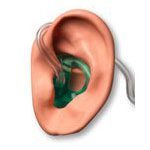History of the Hearing Aid
A hearing aid is a small electronic device worn in or behind the ear that amplifies sounds to someone with hearing loss. Hearing aid technology has improved significantly over the years and today’s hearing amplifiers are vastly more sophisticated than 20 years ago. Nevertheless, only 20 percent of people who could benefit from hearing aids actually use them. NIH-supported researchers are seeking ways to advance hearing aid technology and to develop new hearing device fitting strategies and auditory rehabilitation programs to help improve the communication experience and quality of life for millions of Americans who have hearing loss.
Here is a brief timeline of the history of the hearing aid:
YESTERDAY
- Although hearing devices have been used for centuries, the first electronic hearing aid was developed in the early 1950s. These devices became smaller and more sophisticated over time.
- In the 1970s, directional microphones were incorporated into hearing aids to help a wearer focus on one-to-one conversations in noisy environments.
- In 1992, the NIH and Department of Veterans Affairs (VA) began an innovative collaboration to support the development of more advanced hearing aids.
- In 1995, the NIH, VA, and National Aeronautics and Space Administration (NASA) joined forces to survey all federal laboratories for acoustic or electronic technology that might be applicable to the improvement of hearing aids.
- The first completely digital hearing aids became available commercially in the mid-1990s. Digital aids can be programmed to amplify some frequencies more than others and can be adjusted to the wearer’s needs and to certain listening environments.
- In 1996, NIH and the VA initiated the Hearing Aid Clinical Trial, the first large-scale double-blind, multicenter clinical trial to demonstrate the efficacy of three types of analog hearing aids in both quiet and noisy environments for a wide range of individuals with hearing loss.
TODAY
- An estimated 17 percent of American adults report having some form of hearing loss. Nearly half of adults ages 75 years and older have hearing loss.
- A vast array of hearing aid technologies is currently available, from simple and relatively inexpensive analog circuits to complex and expensive digital devices that require sophisticated fitting procedures. The average price of a digital hearing aid is about $1500, with top-of-the-line devices costing $3000-$5000.
- Over the past two decades, the NIH and VA have cosponsored a biennial conference to facilitate the flow of information among researchers on recent findings and advances in hearing aid technology.
- Scientists continue to search for ways to improve a hearing aid wearer’s ability to understand speech in a noisy background, such as a crowded room.
-
A partnership supported by NIH and NASA, emerging from the 1995 survey of federal agencies, could potentially revolutionize the technology used for directional microphones. The new technology is based on the ears of a parasitic fly, Ormia ochracea.
TOMORROW
- Only one-fifth of people who could benefit from a hearing aid seek intervention. Even among hearing aid users, most have lived with hearing loss for more than ten years before seeking a hearing aid and, by then, their impairment had progressed to moderate-to-severe levels.
- An ongoing clinical dilemma in the management of hearing loss is the level of dissatisfaction that many people with severe hearing loss have for even the most technically advanced hearing aids.
- Scientists are continuing to develop treatments for hearing loss that can be tailored to an individual’s unique needs. The combined use of a hearing aid in one ear and a cochlear implant in the other ear is one treatment being explored in individuals who have some residual hearing.

